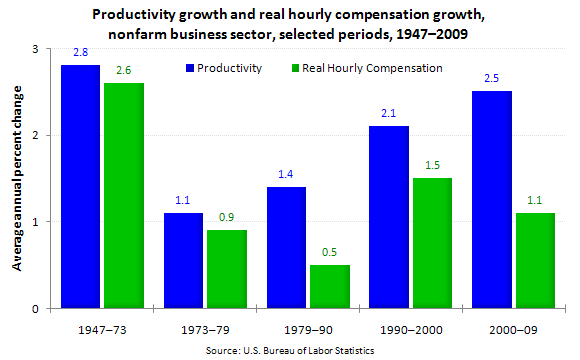February 24, 2011 (The Editor’s Desk is updated each business day.)
The compensation-productivity gap
The gap between real hourly compensation and labor productivity is a "wage gap" that indicates whether workers' compensation is keeping up with productivity. Since the 1970s, growth in inflation-adjusted, or real, hourly compensation—a measure of workers' purchasing power—has lagged behind labor productivity growth.

[Chart data]
Growth of productivity and real hourly compensation in the nonfarm business sector (which accounts for three-fourths of output and employment in the total U.S. economy) was robust until 1973, at which time growth slowed in both measures. During the 1947–73 period, the annual change in productivity averaged 2.8 percent, while real hourly compensation growth averaged 2.6 percent. Over the 1973–79 period, the averages were 1.1 and 0.9 percent, respectively.
Real hourly compensation growth failed to keep pace with accelerating productivity growth over the past three decades, and the gap between productivity growth and compensation growth widened. Over the 2000–09 period, growth in productivity averaged 2.5 percent; growth in real compensation averaged 1.1 percent over the same period.
These earnings data are from the Productivity and Costs program. To learn more, see "The compensation-productivity gap: a visual essay" (PDF) in the January 2011 issue of the Monthly Labor Review.
Related TED articles
Compensation costs | Earnings and wages | Productivity
Of interest
Spotlight on Statistics: National Hispanic Heritage Month
In this Spotlight, we take a look at the Hispanic labor force—including labor force participation, employment and unemployment, educational attainment, geographic location, country of birth, earnings, consumer expenditures, time use, workplace injuries, and employment projections.
.
Read more »
